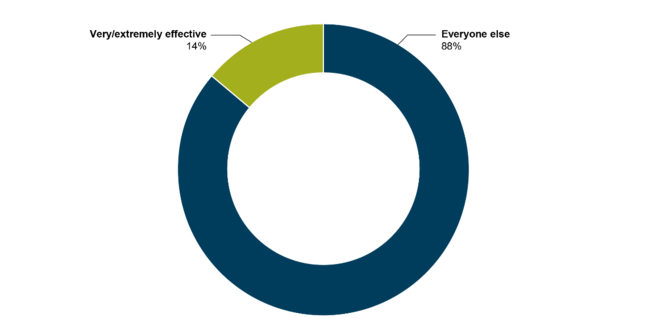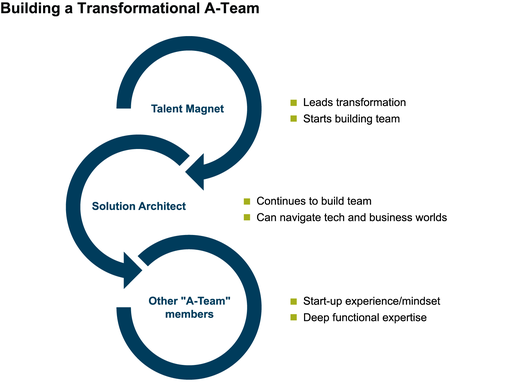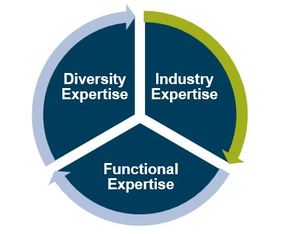Why You Need to Customize Your A-team in the Age of Digital Transformation
Enterprises across the globe are spending trillions of dollars on digital transformation. Are they really getting what they’re paying for?
Digital transformation efforts are disrupting entire industries and the way we do business. According to EY research, 90% of companies are considering allocating capital towards digital priorities in 2020. Digital transformation is an opportunity to increase revenue and cement a competitive advantage. Ignore it, and you’re just surviving and trying to maintain relevance.
However, all the technology and infrastructure investments in the world won’t be worth anything if you don’t have an A-team in place that can (1) visualize what your company needs (2) communicate that vision to relevant stakeholders and (3) execute on that vision.
Do you need a CDO (chief digital officer), a CMO, a CTO, or some combination of all three? Or do you need some new job title that hasn’t been invented yet? Can you restructure your organization to handle a complete disruption, or do you need a separate innovation division?
There’s no one-size-fits all approach. We can’t fly in a transformation superhero or digital fairy godmother. That’s why remaining flexible and creating a customized solution for your organization is the best approach.
The Starting Point
Before you hire an individual or team, you need to be clear about how you’re carrying out your transformation and where you are in the process.
The Industrial Practice at DHR created a “Disruption Maturity Curve” which helps companies determine their readiness to adopt change. The curve can apply to non-industrial enterprises as well.
You also need to have a sense of how your organization will structure the addition of a digital transformation. Your strategy will depend on many factors, including how existing employees can be leveraged, the ability to invest in new talents, and the support granted by the executive suite and at the board level. There are three, maybe four, viable options:
Four Strategies for Carrying Out Digital Transformation
Option 1: Isolate
Create a separate digital organization within the enterprise
- Allows for fresh thinking/ideas since most, if not all, members of the A-Team are external hires
- Division may be dubbed “the cool kids” who are afforded more resources than their legacy counterparts and are given more freedom/creativity
- Examples: Walmart Labs helps Walmart compete with leader Amazon. HomeDepot purchased an Austin-based tech start-up to serve as its in-house digital division, and Caterpillar created Cat Digital
Option 2: Integrate
Transform existing talent throughout organization with rigorous training and development programs
- Can only work if team members are willing to learn new skills and are ready to innovate
- Requires major restructuring of compensation packages, incentives and reporting structures
- Will likely still require hiring of new talent to oversee process
- Typically takes longer than Option 1 because it involves an enterprise-wide culture change
- In some cases, the existing team does not have, or is unable to learn, the required skills set
Option 3: Outsource
Partner with incubators and startups to increase digital capabilities
- Provides a ready-made team that can jump in and begin strategizing and executing plans
- Must be allowed freedom to work
- Examples: The Hershey Company and Lowe’s retained services from Singularity University. Other incubators include in TechNexus Chicago, 1776 in DC, and TechStars in New York
Option 4: Merge
Merge with long-established companies that can expand competencies and services
- Provides both organizations with cross-functional expertise to carry out digital initiatives
- Assimilation can be a challenge
- Examples: Advertising firms purchasing consulting firms (and vice/versa)
The Varied Names – and Roles – of Transformational Leaders
Each one of these options requires new hires- whether it’s leading a new division, building cross-functional teams, or serving as a liaison between the “digital” division and the original organization. The skills and backgrounds of these candidates differ greatly.
Goodbye to the CDO
A CDO – or Chief Digital Officer – is a popular title for the person hired to lead a transformation. In 2013, CDO roles doubled, with salaries ranging from $250,000 to $750,000, according to the CDO Club. However, the role of the CDO may already be on the way out, according to a report from Deloitte. Not because they are no longer needed, but because many have been promoted to take on larger roles within the organization and some have even assumed the CEO role, according to CDO Club.
CDOs typically live at the intersection of technology application, customer experience, and corporate strategy. The CDO is not necessarily a technologist, a marketer, or an innovator but, in fact, embodies a combination of these disciplines. That’s one of the reasons that CDO talent can be difficult to acquire.
So, Who’s Running the Show?
Today, we’re seeing a merging of talents and titles. While the CDO still exists, companies are also using “Officer” titles like Chief Strategy, Customer Experience, Growth, Innovation, or Digital Marketing Officer. Sometimes, the role is simply called “General Manager.”
Some might see this transformational leader as a “futurist” who predicts trends based on current market conditions and then works to assure that the business reacts to those conditions. Others consider the digital leader to be that executive who brings together various disciplines within an enterprise to reinvent the business, thereby creating a new competitive advantage.
To illustrate this unique synthesis of skills and knowledge, consider the following real-life profiles of digital leaders who are currently working in highly visible roles at prominent companies in divergent industries:
Varied Roles and Backgrounds of Transformational Leaders
Financial Services
Official Job Role
Leading business transformation initiatives, developing and implementing strategic technology plans, business processes and organizational design.
Background
BA in English, career start in learning and development. Eventually moved on to technology and managing custom application development projects.
As a Transformational Leader
Demonstrates critical ability to facilitate collaboration across various disciplines. Identifies new channels for the credit business. Example: led the ideation, development and implementation of a mobile app in collaboration with a gas station chain to streamline the credit card application process for customers.
Consumer Goods
Official Job Role
Leading the global digital marketing and customer experience efforts to enable next-generation growth initiatives.
Background
BA in politics and MBA with focus in marketing. Career in brand management.
As a Transformational Leader
Combines marketing, technology, and leadership skills to focus on “precision marketing” through data. Specializes in understanding consumer preferences and behaviors on leverage non-traditional marketing methods. Manages P/Ls and establishes high-performing, cross-functional teams, always with an eye into the future. Reports to Chief Growth Officers. Expertly navigates between creatives, technologists and business leads.
Commerical Container Industry
Official Job Role
Establishing “growth engine” divisions focused on electronic commerce, and creating a culture that promotes creativity, agility and innovation.
Background
BA in communications and journalism, MBA from top business school. Spent much of career running divisions and owning P/Ls, won awards for creating “top places to work.”
As a Transformational Leader
Innovates through creating a culture of collaboration and teamwork. Maintains a fast-paced culture more likely to be found at a startup than a manufacturer.
Finding the Right Mix of Talent
The vast majority of companies find these unique individuals difficult to find. In a 2018 survey by DHR and Harvard Business School, only 14 percent of respondents said they were effective at acquiring, retaining, and developing leaders who were capable of achieving their company’s innovation goals.

Most experts agree that this skills gap isn’t imagined – it’s very real, and it makes it difficult to continue the pace of digital transformation. According to a recent Gartner survey, the global talent shortage is now the top emerging risk facing organizations.
Another factor inhibiting recruitment is that unless you’re Google, Amazon, Facebook or another cool start-up company, your firm might not be considered “exciting” enough by high-caliber individuals. With heated competition for talent, companies need to be very creative in creating a compelling value proposition and ensuring a stellar candidate experience.
Building a Team
Despite the challenges of building a team that will lead, drive and execute your company’s digital transformation, there are proven methods to attract and keep key talent.
At DHR, we advise clients to start with a “talent magnet” – the individual who will lead the digital transformation with activities like bringing new products to market, developing new business models, and establishing a high-performing team. This is your CDO — or whatever title you choose – who understands your business, is familiar with enabling technologies, and can break down silos across the enterprise.
The first task of the “magnet” is to quickly onboard a solution architect with the unique ability to navigate both the advanced technology realm and the business world. Ideally, this individual is experienced in dealing with ambiguity and is an out-of-the-box thinker who can operate in a lean environment especially since they will be employee #2 in this new digital organization.
Once these two key roles are in place, they become a draw for other talents. As you assemble the team, consider key characteristics such as entrepreneurial experience, collaborative skills, and subject matter expertise.
As a new organization within your company, resources will be limited while the expectation to produce will be high. Team members who can be agile and creative much like those in a startup will bring tremendous value to the organization. They must also have the ability to work with other experts within the organization and across other business units, the IT organization and the marketing department. At some point, products and ideas developed in the digital organization will need to be operationalized and commercialized, requiring a handoff to the IT organization and ultimately to the operating business units from the legacy organization. Lastly, A-team members must have deep knowledge in one or two areas which may include big data and analytics, software development life cycle, creative and design, or knowledge of the digital ecosystem.

Widening the Net
As a search firm, we employ a number of tactics to find the right leaders who can contribute to this A-team. For example, we often look for candidates in peripheral geographic areas where commuting is an option. And, there is always telecommuting, which opens our search to the entire globe. Software engineering is probably one of a few professions where physical presence in the home office can be optional.
Moreover, instead of poaching at high-tech companies, we seek out candidates across various industries where recent digital transformations have transpired. Companies are very vocal about digital transformation initiatives either on analyst calls for publicly traded companies or via traditional and digital news outlets. Employees recruited from these companies will have the digital transformation experience and offer lessons learned.
Technology is another way we reach and review more candidates. Job aggregators, testing tools, artificial intelligence, automation tools, applicant tracking, CRM, video interviewing, chatbots and texting apps are just a few of the tools we use. Texting, as an example, is very powerful in attracting millennials who rely on it for communications. Artificial Intelligence can often be useful in eliminating unconscious bias in the recruiting process. Video interviewing is another area where tech is an advantage. Recruiters can pre-record screening questions for prospective candidates and the same tool can capture the video responses seamlessly, thereby eliminating time-consuming screening processes and schedule coordination that extends recruiting process timelines.
the recruiting process. Video interviewing is another area where tech is an advantage. Recruiters can pre-record screening questions for prospective candidates and the same tool can capture the video responses seamlessly, thereby eliminating time-consuming screening processes and schedule coordination that extends recruiting process timelines.
Finally, there is the internal networking system at DHR. Search teams always include multi-disciplinary expertise to tap into talent that is diverse in demographics, experience, and skills.
Summary: Building Your A-Team
At DHR, we’ve conducted hundreds of searches to source multi-faceted candidates who can lead and contribute to major organizational transformations.
Here is a quick summary of the points discussed above for attracting and retaining an A-team of digital leaders:
- Understand where you are on the Disruption Maturity Curve and how your company wants to tackle its digital transformation.
- Be flexible when defining job roles and requirements. Excellent candidates can come from a wide variety of backgrounds.
- Consider a mixed team approach – build complete capabilities in a team versus an individual by leveraging the gig economy and engaging specialists for critical skills needs.
- Look first for a “talent magnet” who can draw more qualified individuals to your company and build a strong team.
- Establish your brand to attract top talent. Position your company as a workplace that values innovation and agility.
- When evaluating candidates, consider adjacent industries. For example, financial services, retail, and technology are leading in digital journey and are excellent sources for deep digital expertise.
- Tap other geography for talent – digital skills growing in Asia, Latin America, and Eastern Europe.
The leaders you hire today will be the ones to take your organization through a critical transformation period and keep it thriving for years to come. Get in touch about where you want to go, and we can help find those leaders who will take you there.
